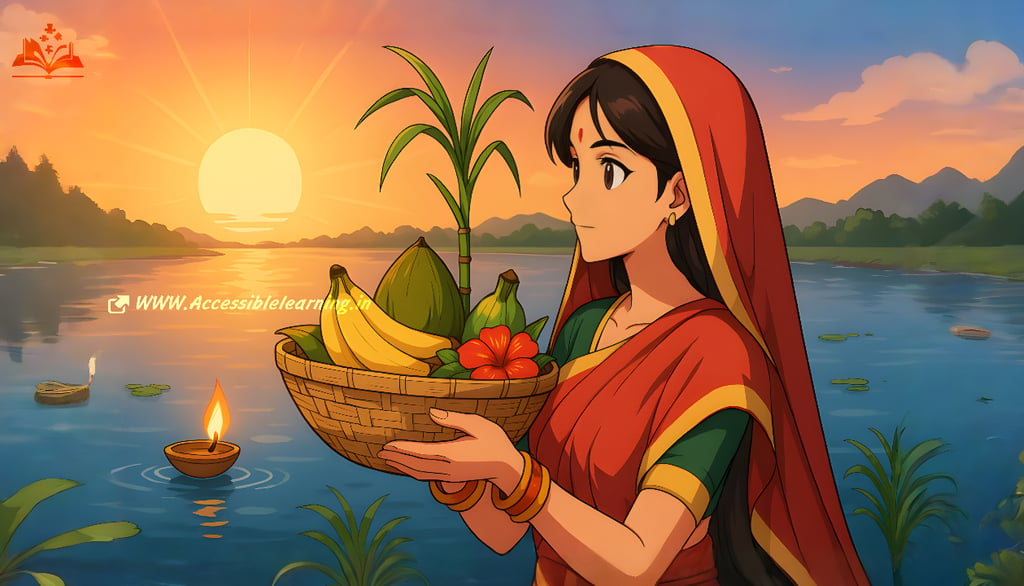
Chhath Puja: History, Importance, and Rituals of Sun Worship Festival
Chhath Puja is an ancient Hindu festival dedicated to the Sun God and Chhathi Maiya. Discover its history, rituals, importance, and modern relevance. Learn why and how Chhath Puja is celebrated, its spiritual significance, and its role in connecting humans with nature.
CULTURE/TRADITIONEVENT/SPECIALINDIA/BHARATCELEBRATION/FESTIVALS
Keshav Jha
10/19/20253 min read


Chhath Puja is one of the most significant and ancient Hindu festivals dedicated to the worship of the Sun God (Surya Dev) and Chhathi Maiya. Primarily observed in the Indian states of Bihar, Jharkhand, Uttar Pradesh, and parts of Nepal, this festival has now gained recognition worldwide due to the migration of Indian communities. Known for its simplicity, purity, and discipline, Chhath Puja reflects deep respect for nature and the cosmic forces that sustain life.
In this article, we’ll explore the importance of Chhath Puja, its history, rituals, scientific relevance, and how it is celebrated.
The Importance of Chhath Puja
Chhath Puja is not just a ritual but a festival of gratitude and sustainability. Devotees thank the Sun God for sustaining life on Earth and seek blessings for health, prosperity, and well-being.
Sun as the Source of Energy: The Sun is regarded as the ultimate source of life. Worshipping Surya Dev symbolizes respect for energy, light, and positivity.
Chhathi Maiya: A manifestation of Mother Nature, she is believed to protect children and grant longevity, happiness, and strength to families.
Spiritual Discipline: Observing strict fasts, purity, and rituals connects the devotee with inner strength, patience, and self-control.
Social Harmony: Chhath Puja is celebrated collectively on riverbanks and ponds, reflecting unity, equality, and simplicity.
History and Mythology of Chhath Puja
The origins of Chhath Puja can be traced to Vedic times. Ancient texts suggest that sages performed rituals to the Sun God for energy and healing.
Some important mythological associations include:
Ramayan: After returning from exile, Ram Ji and Maa Sita observed Chhath rituals and offered prayers to Surya Dev.
Mahabharata: Draupadi and the Pandavas performed Chhath Puja to overcome difficulties and regain their kingdom.
Surya Worship: Since ancient India, Surya has been worshipped for vitality and prosperity, and Chhath is believed to continue that timeless tradition.
Rituals of Chhath Puja—Step by Step
Chhath Puja is celebrated over four days of devotion, discipline, and purity. Each day has unique significance:
1. Nahay Khay (Day 1)
Devotees take a holy dip in rivers or ponds.
They prepare a simple satvik meal, often of pumpkin, rice, and gram dal.
This meal marks the beginning of purity and cleansing.
2. Lohanda & Kharna (Day 2)
Devotees observe a full-day fast without food and water.
In the evening, they prepare kheer (made of jaggery, rice, and milk) and chapati as prasad.
After offering it to the Sun, devotees break the fast and then begin a 36-hour nirjala fast (without food or water).
3. Sandhya Arghya (Day 3)
The most significant ritual of Chhath.
Devotees, dressed in traditional attire, gather at riverbanks.
They offer arghya (water and milk) to the setting sun, accompanied by folk songs and prayers.
The scene is spiritual, vibrant, and deeply emotional.
4. Usha Arghya (Day 4)
The final day of Chhath Puja.
Devotees offer prayers to the rising sun, symbolizing new beginnings and hope.
After the rituals, they break their long fast with prasad.

Scientific and Health Relevance
Chhath Puja is deeply rooted in science and health benefits:
Vitamin D Absorption: Offering prayers to the rising and setting sun boosts Vitamin D, crucial for bones and immunity.
Detoxification: Fasting and consuming satvik food purify the body and aid digestion.
Mental Peace: Meditation, discipline, and connection with nature calm the mind and enhance inner strength.
Eco-Friendly Practices: Use of biodegradable materials (bananas, sugarcane, bamboo baskets, earthen lamps) shows sustainability in rituals.
How Chhath Puja is Celebrated Today
In India: Especially grand in Bihar, Uttar Pradesh, and Jharkhand with decorated ghats, community songs, and massive participation.
Across the World: NRIs celebrate in countries like the U.S., U.K., Mauritius, and UAE, keeping the tradition alive abroad.
Modern Adaptations: While maintaining purity, eco-friendly practices are being emphasized, replacing plastics with clay and bamboo.
Why Chhath Puja Matters Today
In today’s fast-paced life, Chhath Puja reminds us of:
Gratitude for Nature: Without the Sun, life would not exist.
Unity in Diversity: People of all castes, classes, and communities come together at the ghats.
Health and Discipline: The rituals encourage detox, self-control, and mindfulness.
Cultural Pride: For Biharis and eastern Indians, Chhath is an identity and heritage, keeping cultural roots strong.
Chhath Puja is not just a religious festival but a celebration of life, nature, and discipline. Its rituals symbolize the harmony between humans and cosmic forces. Whether it’s thanking the Sun God, honoring Chhathi Maiya, or embracing eco-friendly traditions, Chhath Puja continues to inspire generations with its timeless values of faith, purity, and gratitude.
As the chants of “Chhath Maiya ki Jai” echo across rivers and ponds, this festival reminds us that true devotion lies in simplicity, sincerity, and respect for the natural world.
Subscribe to our newsletter
All © Copyright reserved by Accessible-Learning
| Terms & Conditions
Knowledge is power. Learn with Us. 📚


